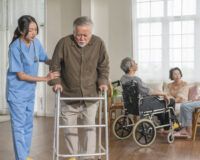Introduction
As seniors age, their needs change, and creating a safe, supportive, and comfortable home environment becomes essential to maintaining their quality of life.
Seniors, particularly those with mobility limitations or health conditions, benefit greatly from adjustments to their living spaces that make daily tasks easier and prevent potential hazards. A well-designed home environment can reduce the risk of injuries, boost emotional well-being, and ensure seniors can continue living independently and with dignity.
At Care For You India, we understand the importance of a secure and comfortable setting for seniors, and we’re here to guide you through creating the ideal space.
Why Safe and Comfort Care Living is Important for Seniors
Safe and comfortable care in senior living is crucial for physical and emotional health. Studies have shown that around one-third of people over 65 years of age experience falls every year, making fall prevention one of the primary considerations in senior living.
In addition to physical safety, a comfortable environment has a positive impact on mental health. Seniors often spend more time at home than younger adults, so ensuring the space is both functional and comforting can significantly improve their quality of life.
Many seniors also face isolation and emotional challenges. A warm, welcoming environment can cultivate a sense of belonging, and by designing spaces with their specific needs in mind, families and caregivers can help seniors feel more independent and valued.
Creating a Safe and Comfortable Environment for the Elderly
Creating an environment that is safe and comfortable for seniors involves adjustments to several areas in the home. Here are some practical steps that you can take:
- Fall-Proofing the Home
Falls are one of the most common risks for seniors. Simple changes can make a substantial difference in preventing falls:
- Remove Tripping Hazards: Clear walkways of clutter, loose rugs, and electrical cords. Make sure that all pathways are wide enough to accommodate walkers or wheelchairs if necessary.
- Install Grab Bars: Place sturdy grab bars in bathrooms next to the toilet, shower, and bathtub to provide additional support.
- Non-Slip Mats: Use non-slip mats in areas prone to getting wet, like the bathroom or kitchen, to reduce the risk of slipping.
- Adequate Lighting: Ensure that all areas of the home, especially stairways and hallways, are well-lit to prevent falls due to poor visibility. Consider installing nightlights to assist with evening or late-night trips to the bathroom.
- Making Essential Rooms Accessible
Accessibility can make a huge difference in comfort care in senior living by enabling seniors to move freely and perform daily tasks independently:
- Bathroom Accessibility: Modify the bathroom to include a walk-in shower or a low-threshold bathtub. Adjustable showerheads and a shower chair can also add comfort and ease.
- Kitchen Adjustments: Arrange frequently used items in lower cabinets and drawers to avoid reaching or using step stools. Lever-style taps are easier for seniors to use, especially those with arthritis.
- Bedroom Safety: For added safety, place the bed in a position that allows for easy access. Installing bed rails can help seniors get in and out of bed safely, while bed risers can be helpful for those who find it hard to bend low.
- Enhancing Comfort for Emotional Well-Being
Comfort is about more than physical safety; it also involves creating a nurturing atmosphere. Here are a few ways to make the home more inviting:
- Familiar Surroundings: Decorate with familiar items, like family photos, art, or keepsakes. Familiarity provides comfort and reassurance, especially for seniors with memory issues.
- Cosy Furniture: Choose seating that is both supportive and comfortable. Chairs with sturdy armrests can help seniors stand up more easily.
- Temperature Control: As seniors often feel cold more easily, make sure the home’s temperature is comfortably warm. Provide easy access to blankets, and ensure heating systems are well-maintained.
- Quiet and Calm Spaces: Designate a quiet area where seniors can relax, read, or engage in hobbies. This could include a favourite armchair by a window or a small nook where they can enjoy peaceful moments.
- Supporting Daily Routines and Independence
Independence is key to enhancing self-esteem and well-being. By supporting seniors in maintaining daily routines, we create a more dignified living experience:
- Accessible Storage: Ensure items are stored within reach to reduce the need for stretching or bending.
- Adaptive Aids: Provide adaptive tools, like grabbers for reaching high objects, utensils with larger handles, or easy-to-open containers. These small aids can make a big difference in a comfortable senior care setting.
- Smart Home Features: Technology can play an essential role in maintaining independence. Consider adding voice-activated systems for controlling lights, setting reminders, or even calling family members. Devices like medical alert systems are also beneficial, allowing seniors to call for help if needed.
- Social and Recreational Spaces
Social interaction is essential for mental health, especially for seniors who may feel isolated:
- Create Gathering Areas: Designate a comfortable area where family and friends can gather. This could be a cosy living room space or a small garden where seniors can enjoy the company.
- Access to Hobbies: Set up spaces that encourage engagement in hobbies, whether it’s a small table for puzzles, a corner for painting, or a spot for gardening. These activities contribute to mental stimulation and joy.
- Encourage Outdoor Time: If possible, create an accessible outdoor area with seating, shade, and safe paths. Time spent in nature can enhance mood, reduce stress, and encourage physical activity.
Additional Considerations for Safety and Comfort in Senior Living
- Regular Home Maintenance: Regular checks of the home’s safety features, like smoke detectors and heating systems, are essential. Keeping appliances and fixtures in good repair helps prevent accidents.
- Emergency Preparedness: Prepare a simple emergency plan that includes contact numbers for family members, doctors, and emergency services. Keep it in an easily accessible location.
- Medication Management: Organise medications in a clear, labelled system, and consider using a pill organiser. Technology like reminder apps or automated dispensers can assist with medication adherence.
Conclusion
Creating a safe and comfortable home environment for seniors is more than a matter of convenience; it’s essential for their physical health, emotional well-being, and sense of independence. By addressing safety and comfort, families can help seniors live fulfilling, empowered lives within their own homes. With attention to small but impactful details, senior living can be made not only manageable but truly enjoyable for elderly loved ones.
At Care For You India, we are committed to supporting seniors and their families by helping to create environments that promote comfortable care senior living. These thoughtful adjustments are steps toward providing the respect, dignity, and quality of life that every senior deserves.





